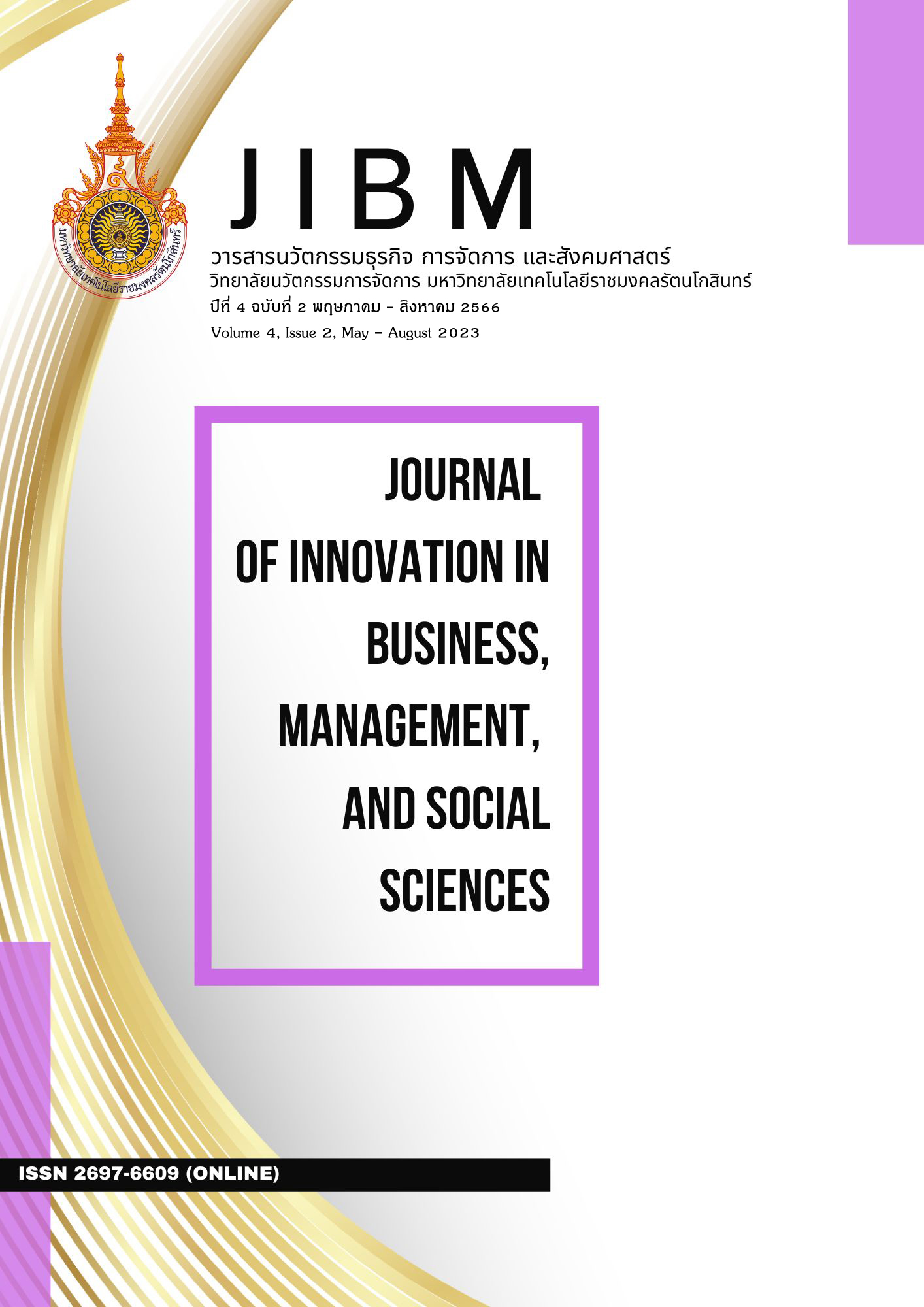ปัจจัยที่มีผลต่อส่วนเกินมูลค่าการซื้อกิจการ (Takeover premium) ของบริษัทเป้าหมายในประเทศไทย และการเกิดมูลค่าเพิ่มจากการร่วมมือกัน (Synergy)
คำสำคัญ:
Merger and Acquisition, Takeover Premium, Synergy, Cumulative Abnormal Returnบทคัดย่อ
งานวิจัยนี้ศึกษาปัจจัยที่มีผลต่อส่วนเกินมูลค่าการซื้อกิจการ (Takeover Premium) ในการควบรวมกิจการของบริษัทเป้าหมายในประเทศไทย โดยใช้ข้อมูลการควบรวมกิจการของบริษัทในประเทศไทย
ซึ่งดำเนินการซื้อกิจการเสร็จสิ้นแล้วตั้งแต่ปี พ.ศ. 2545 ถึง 2563 โดยคัดเลือกเฉพาะข้อมูลที่บริษัทเป้าหมายเป็นบริษัทที่จดทะเบียนในตลาดหลักทรัพย์แห่งประเทศไทยที่มีราคาเป้าหมายของนักวิเคราะห์
โดยใช้ข้อมูลรวมภาคตัดขวาง (Pooled Cross-section Data) และศึกษาตัวแปรอัตราผลตอบแทน
ที่คาดหวังจากราคาเป้าหมาย (Target Price Implied Expected Return; TPER) มูลค่าตลาดของบริษัทเป้าหมาย (Market Capitalization of the Target Company) การชำระค่าหุ้นด้วยเงินสดทั้งหมด (All-cash Offer)
การทำคำเสนอซื้อหลักทรัพย์ (Tender Offer) ลักษณะการควบรวมกิจการ (Friendly Takeover or Other) สถานะของผู้ซื้อ (Public or Other) และรหัสมาตรฐานอุตสาหกรรม (Standard Industrial Classification; SIC) โดยศึกษาทั้งการควบรวมกิจการในกลุ่มธุรกิจเดียวกัน และในกลุ่มธุรกิจต่างกัน นอกจากนี้ยังศึกษามูลค่าเพิ่มจากการร่วมกัน (Synergy) ผ่านอัตราผลตอบแทนที่เกินปกติสะสมจากการประกาศควบรวมกิจการ (Cumulative Abnormal Return)
ผลการศึกษาพบว่า อัตราผลตอบแทนที่คาดหวังจากราคาเป้าหมาย การชำระค่าหุ้นด้วยเงินสดทั้งหมด การทำคำเสนอซื้อหลักทรัพย์ และลักษณะการควบรวมกิจการที่ไม่ใช่แบบเป็นมิตร
(Hostile, Neutral, Unknown) มีความสัมพันธ์เชิงบวกต่อส่วนเกินมูลค่าการซื้อกิจการอย่างมีนัยสำคัญ
ขณะที่มูลค่าตลาดของบริษัทเป้าหมายมีความสัมพันธ์เชิงลบต่อส่วนเกินมูลค่าการซื้อกิจการอย่างมีนัยสำคัญ และพบว่าอัตราผลตอบแทนที่เกินปกติเฉลี่ยสะสม (Cumulative Average Abnormal Return; CAAR)
จากการประกาศควบรวมกิจการของบริษัทเป้าหมาย ผู้ซื้อ และ บริษัทเป้าหมายและผู้ซื้อรวมกันล้วนเป็นบวก ณ วันที่ประกาศควบรวมกิจการอย่างมีนัยสำคัญ
เอกสารอ้างอิง
Agrawal, A., Jaffe, J. F., & Mandelker, G. N. (1992). The Post-Merger Performance of Acquiring Firms: A Re-examination of an Anomaly. Journal of Finance, 47(4), 1605-1621.
Alexandridis, G., Fuller, K. P., Terhaar, L., & Travlos, N. G. (2013). Deal Size, Acquisition Premia and Shareholder Gains. Journal of Corporate Finance, 20(1), 1-13.
Asquith, P., & Kim, E. H. (1982). The Impact of Merger Bids on the Participating Firms' Security Holders. Journal of Finance, 37(5), 1209-1228.
Baker, M., Pan, X., & Wurgler, J. (2012). The Effect of Reference Point Prices on Mergers and Acquisitions. Journal of Financial Economics, 106(1), 49-71.
Bargeron, L. L., Schlingemann, F. P., Stulz, R. M., & Zutter, C. J. (2008). Why Do Private Acquirers Pay So Little Compared to Public Acquirers? Journal of Financial Economics, 89(3), 375–390.
Bhagat, S., Brickley, J. A., & Loewenstein, U. (1987). The Pricing Effects of Interfirm Cash Tender Offers. Journal of Finance, 42(4), 965-986.
Bonini, S., Zanetti, L., Bianchini, R., & Salvi, A. (2010). Target Price Accuracy in Equity Research. Journal of Business Finance & Accounting, 37(9-10), 1177–1217.
Capron, L., & Pistre, N. (2002). When Do Acquirers Earn Abnormal Returns? Strategic Management Journal, 23(9), 781-794.
Díaz, B. D., Azofra, S. S., & Gutiérrez, C. L. (2009). Are M&A Premiums Too High? Analysis of a Quadratic Relationship between Premiums and Returns. Journal of Finance and Accounting, 48(3), 5-21.
Fama, E. F. (1970). Efficient Capital Markets: A Review of Theory and Empirical Work. Journal of Finance, 25(2), 383-417.
Franks, J., & Mayer, C. (1996). Hostile Takeovers and the Correction of Managerial Failure. Journal of Financial Economics, 40(1), 163-181.
Gaspar, J.-M., Massa, M., & Matos, P. (2005). Shareholder Investment Horizons and the Market for Corporate Control. Journal of Financial Economics, 76(1), 135-165.
Gerritsen, D. F. (2015). Security Analysts’ Target Prices and Takeover Premiums. Finance Research Letters, 13(2), 205-213.
Goergen, M., & Renneboog, L. (2004). Shareholder Wealth Effects of European Domestic and Cross-border Takeover Bids. European Financial Management, 10(1), 9-45.
Hitt, M. A., King, D. R., Krishnan, H., Makri, M., Schijven, M., Shimizu, K., & Zhu, H. (2012). Creating Value Through Mergers and Acquisitions: Challenges and Opportunities. In D. Faulkner, S. Teerikangas, & R. J. Joseph (Eds.), The Handbook of Mergers and Acquisitions (Vol. 1, pp. 124-185). Oxford: Oxford University Press: Oxford University Press.
Hou, K., Olsson, P., & Robinson, D. T. (2000). Does Takeover Increase Stockholder Value. University of Chicago Graduate School of Business, ResearchGate.
III, W. N. D., & Cheng, L. T. W. (1997). Target Firm Returns: Does the Form of Payment Affect Abnormal Returns? Journal of Business Finance & Accounting, 24(3-4), 465-479.
Ismail, A. (2011). Does the Management's Forecast of Merger Synergies Explain the Premium Paid, the Method of Payment, and Merger Motives? Financial Management, 40(4), 879-910.
Jensen, M. C. (1988). Takeovers: Their Causes and Consequences. Journal of Economic Perspectives, 2(1), 21-48.
Krishnan, H. A., Krishnan, R., & Lefanowicz, C. E. (2013). Market Perception of Synergies in Related Acquisitions. Electronic Business Journal, 12(6), 451-471.
Meier, J.-H., Paientko, D. T., & Meinzer, C. R. (2019). Determinants of Acquisition Premiums in M&A-Transactions - An Analysis of Deal Characteristics. Research Paper. Lucerne University of Applied Sciences and Arts.
Offenberg, D., & Pirinsky, C. (2015). How Do Acquirers Choose Between Mergers and Tender Offers? Journal of Financial Economics, 116(2), 331-348.
Sanders, R., & Zdanowicz, J. (1992). Target Firm Abnormal Returns and Trading Volume around the Initiation of Change in Control Transactions. Journal of Financial and Quantitative Analysis, 27(1), 109-129.
Schwert, G. W. (1996). Markup Pricing in Mergers and Acquisitions. Journal of Financial Economics, 41(2), 153-192.
Sharma, D. S., & Ho, J. (2002). The Impact of Acquisitions on Operating Performance: Some Australian Evidence. Journal of Business Finance & Accounting, 29(1&2), 155-200.
Shleifer, A., & Vishny, R. W. (2003). Stock Market Driven Acquisitions. Journal of Financial Economics, 70(3), 295–311.
ตลาดหลักทรัพย์แห่งประเทศไทย. (2555). M&A: Mergers and Acquisitions ทางเลือกสู่ความสำเร็จธุรกิจไทย.
ตลาดหลักทรัพย์แห่งประเทศไทย. (2557). รู้เฟื่องควบรวมกิจการ : โอกาสของธุรกิจไทย.
ตลาดหลักทรัพย์แห่งประเทศไทย. (2564). การทำคำเสนอซื้อหุ้นต่อผู้ถือหุ้นทั่วไป. Retrieved from https://www.set.or.th/set/education/glossary.do
ธาตรี จันทรโคลิกา. (2564). เอกสารประกอบการเรียนวิชา Econometrics and Finance Research.
วิทยาลัยการจัดการ มหาวิทยาลัยมหิดล.
นิธิภัทร กมลสุข. (2561). การประมาณค่าที่แกร่งโดยใช้การประมาณค่า M และการประมาณค่า S.
วารสารการวิจัยกาสะลองคำ, 12(2), 56-68.
รมิตา ปวิดาภา, กนกพร สาดเสาเงิน และ ธนกร วุฒิพงษ์. (2559). การตอบสนองของราคาหลักทรัพย์
จากการประกาศควบรวมกิจการ ของบริษัทที่จดทะเบียนในตลาดหลักทรัพย์แห่งประเทศไทย. (ปริญญาโท), วิทยาลัยการจัดการ มหาวิทยาลัยมหิดล.
วิษณุ วงศ์สินศิริกุล. (2563). ทำผิดเพราะไม่รู้ ไม่ต่างจากทำผิดทั้งที่รู้. Retrieved from https://www.bangkokbiznews.com/blog/detail/650026
สำนักงานคณะกรรมการกำกับหลักทรัพย์และตลาดหลักทรัพย์. (2562). การทำคำเสนอซื้อหลักทรัพย์ /
การยกเว้นหน้าที่ทำคำเสนอซื้อหลักทรัพย์เป็นการทั่วไป. Retrieved from https://www.sec.or.th/th/pages/lawandregulations/makingwaiver.aspx
อวยชัย สุขวงค์. (2548). รอบรู้...เรื่องการควบโอนกิจการ (1). วารสารธรรมนิติ ฉบับเอกสารภาษีอากร, 283, 1-9.
อัญญา ขันธวิทย์. (2540). การควบกิจการและการครอบงำกิจการ (Vol. พิมพ์ครั้งที่ 3): กรุงเทพฯ: คณะพาณิชยศาสตร์และการบัญชี มหาวิทยาลัยธรรมศาสตร์.



